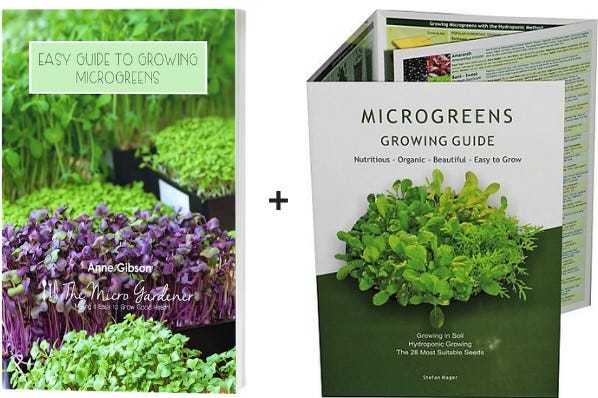April Gardening Tips
What to plant now, caterpillars, garden tasks + tips for new season planning wherever you live
With seasonal changes, it’s a good time to reflect and plan what to grow. Weather challenges have thrown plans for many gardeners out the window. If it’s too hot, wet, cold or wild outside, I believe maintaining a connection to nature remains vital for our overall health and wellbeing.
A few simple ideas include:
Nurture indoor pot plants. Water, prune or feed them. They improve your indoor air, so give them a little love in return.
Use the time indoors to save seeds or go through your seed bank. Select seasonal varieties to sow or out-of-date seeds that need planting this season.
Sow microgreens or sprouts and enjoy watching these nutritious baby plants grow. They are nutrient-dense ‘healthy fast food’ that are easy to grow indoors. These quick start guides show you how.
April in the Garden
If you’re in my subtropical climate in southeast Queensland, dig into the tips below. I share everything you need to know in my comprehensive monthly guide!
The laminated Subtropical Planting Guide is designed for this climate with our five seasons, what to plant, seasonal garden tasks and common pests at different times of the year. It’s a planning and planting tool to use year after year.
If you’re interested in the BOM long-range forecast for Australia, you can check it out here. Not that I put much faith in what some call the ‘Bureau Of Manure’!
Live in a different climate zone? Discover what to plant and when, or read the tips below. I’ve got practical advice to share for every climate. Check out my April Garden Tour and Harvests for an over-the-fence virtual view into my kitchen garden.
Preparing for Spring Gardening – Northern Hemisphere
As the season changes and the soil warms up, you may be preparing to start your Spring garden. Now is a time to focus on getting your garden ready for the warmer months. These are a few tips to help you.
1. Reflect and record what plants grew well or gave you JOY or a great harvest last year. Which plants were pest or disease magnets, hard to manage or unproductive? Avoid these and maybe try new varieties or species. Or a new spot? If you haven’t noted your observations in a garden journal yet, now’s a good time to do so!
2. Plan your space. Are you going to start small with a few containers or a raised garden bed? Or are you thinking BIG? Wherever you plan to grow this season, match your plants to their preferred microclimate. Sunny, shady, wet or dry?
3. Prepare your soil, potting mix or seed raising medium. Whether you buy in materials or make your own, your plant health and productivity depend on what they grow in. Healthy soil = productive plants.
4. Sow seasonal seeds suited to your climate zone so your seedlings will be ready to plant. Organise garden supplies like stakes, fertiliser and plant labels.
Resources to help you succeed
Coping with Caterpillars
If you have annoying wriggly little moth and butterfly larvae (their ‘kids’) eating your leaves, they are manageable. It’s the ones inside fruit, like Codling Moth caterpillars and Budworms, that can be harder to control, as you may not notice them.
Why are they there? Moths and butterflies are responsible mothers. They lay eggs on ‘host’ plants that are their babies’ favourite foods. So when eggs hatch, the larvae open their tiny mouths and take a bite. How thoughtful!
Are all caterpillars bad? Only a handful of species cause major damage. The rest are just butterflies and moths living their best life! Let them be. The most destructive species are Diamondback Moth (Plutella xylostella); Cabbage White Butterfly (Pieris rapae); Helicoverpa Caterpillars (Helicoverpa armigera and Helicoverpa punctigera) or Corn earworms and budworms; Looper Caterpillars (Chrysodeixis spp.); Cluster Caterpillar (Spodoptera litura) and Cutworms (Agrotis spp.). Learn to identify them.
How can you tell if caterpillars are causing a problem? When larvae are small, they don’t eat much. But as the caterpillars get a taste for your yummy produce, they get bigger and so does their appetite! You may notice small to large holes in leaves and sometimes fruit. Another clue is little brown ‘dots’ on the leaves. This is ‘frass’ or insect poop - plant material they have eaten and digested. A polite way of saying they’ve been to the toilet! Put your detective hat on and look closely.
Frass is a telltale sign that caterpillars are in residence, often on a leaf above where you see it. However, sometimes the culprits are still at the scene of the crime!
Learn more about identifying and managing caterpillars:
Coping with Caterpillars - Part 1: Who’s who - do you really have a problem?
Coping with Caterpillars - Part 2: 13 Sneaky Strategies to Manage Caterpillars
May you fill your cup with joy from the garden. I look forward to sharing more ways to grow good health soon. I’d love your feedback so please leave a comment.
Have a beautiful day, Anne
🐝 If this sparked a new idea or cross-pollinated your thinking, a coffee keeps the buzz going.
AI Notice: This content is not authorised for AI training, scraping, or summarisation. © Anne Gibson, All rights reserved 2025.













